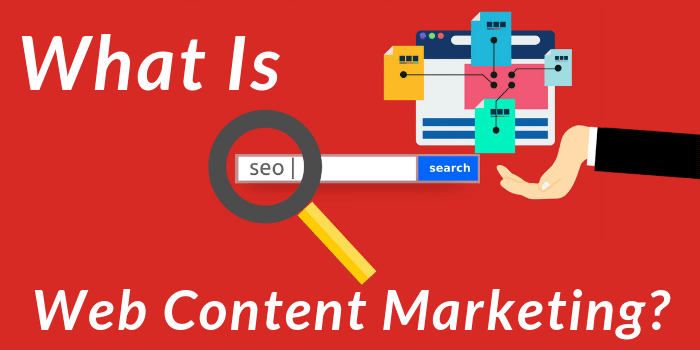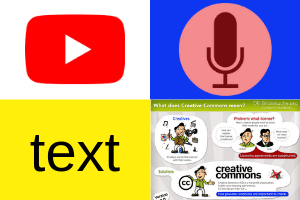What is web content marketing? Is it so important to your business? No doubt you've heard the phrase "content is king." Why? Because content is what builds credibility and loyalty to your potential customers. Then it only makes sense if the 'content' is always at the core of your marketing plan no matter what kind of business you provide. But what really is it?

Businesses are not built on first-time buyers. Companies don't make most of their money from people using just one product at just one time. They should be making money from people who liked their initial trial of the product then decided it was good enough to purchase it over and over again, and also decided to give other products that are for sale. If a business had to get a new customer every time in order to get paid, they'd all have gone by now.
Yet many new business owners try to approach that way when marketing their products online. Instead of focusing on repeat visitors, they focus on optimizing for search engines so they get more new customers.
Think about the famous blogs such as Huffington Post or TechCrunch; they get most of their traffic from repeat visitors. Search engines love them, but their businesses would be a fraction of what they are today if they didn't have an ability to keep producing great content.
Search Engines
For many years, Google and other search engines such as Bing! and Yahoo have worked towards making their search results pull up more useful results, meaningful results for the users. They want people to find the best content possible that matches what they're looking for.
As search engines get smarter, marketers who focus primarily on marketing tactics rather than actual content will consistently lose ground to competitors who understand the importance of creating a consistent flow of quality content for their consumers.
Google has proven this repeatedly by continually downgrading the importance of low-quality links and upgrading the importance of usage statistics and other metrics to measure the content of a website.
If you build your website around great content while having a decent understanding of basic SEO, your site will grow. If you put all your attention on SEO and don't pay much attention to your content, you'll always be trying to stay one step ahead of the search engines.
Four Types Of Content
There are different forms of content that you can use to grow your business; the main four types are, text, graphics, video and audio. Each type has its own benefits and will appeal to different audiences. I will now explain the characteristics of each type.
#1 Text Content
Text is by far the most common type of content used on the internet. Just about every webpage you see is based on text content. The biggest benefit of text-based content is without a doubt, it's search engine friendly. Search engines themselves are text-based and can only crawl text documents. While videos, audio and images need to be tagged with supplementary keywords, if you're publishing text-based content you stand a good chance of ranking without specifying meta tags.
#2 Graphics
This is visual based content like social memes, banners and infographics that are easily shared on sites like Pinterest, Instagram and various paid advertising platforms. These are essentially graphics that contain information that appeals to your target audience. One of the biggest benefits of graphic based content is that it's often more entertaining and informative than just plain text.
#3 Audio Content
Audio content, especially in the form of podcasts and audiobooks is a dark horse. People can listen to audio anywhere they go. In the car, on the bus, while walking, at lunch, etc. It saves time and is extremely convenient. Audio content works well for many businesses, not to be underestimated.
#4 Video Content
YouTube is the 2nd most popular search engine in the world, and video is one of the most dynamic methods of distributing content on the internet. It also has some of the strongest "share cultures." It's very easy to share video content with friends on Facebook for example. A video has a much higher chance of going viral than say an audio podcast.
Read More: Content Marketing Strategy
Which Content Format Is Right For You?

It really depends on what kind of content you're creating and who your market is. The best way to find out is to test and track your results. You can also try a combination of different types of content to see what your audience responds the best to.
It also depends on what you are good at. Some may feel that it takes more effort to produce video content than to write an article. Some may find creating infographics most enjoyable but time-consuming.
Find Your Voice As A Content Marketer
When you read content by someone who's found their voice, there's a distinct ring to it. You can tell they're passionate and really know what they're talking about.
People are moved by those who speak with their real voice. Yet what most people don't realize is that almost everyone who's found their voice had to put in a lot of work to find that voice. It doesn't usually come naturally. So how do you find your voice as a content marketer?
Start With What You're Most Passionate About
If you love sports get into that sports field. If internet marketing is your thing write about that. If you love crafting, target that niche.
- What is a topic that you could talk about for hours on end?
- What would you talk about and obsess about even if you weren't getting paid?
- What's something that really lights you up in life and gets you excited?
While not every passion can be turned into an occupation, you'd be surprised at how many people do manage to turn their passions into money, even in very obscure niches. When you create content around a topic that you love it'll come through in your voice.
Be Self-Expressive
Try to write without censorship. Don't worry too much about political correctness or the proper grammar. I'm not saying be sloppy, just focus more on the message you're trying to convey. If you're speaking from your real voice, you're probably going to turn some people off. However, you'll also really attract the kinds of people that will be more likely to make a purchase from you.
People who have strong voices stand out. Some people like them, others might hate them. But that's how real followings are built. Rarely is a following built from people who try to please everyone.
When you're creating content, try to write as if you were speaking one on one to a friend. Write naturally, in a casual yet self-expressed and passionate manner.
Focus On The Impact You Want To Make
Can you tell the difference between someone who's written something and really cares if you succeed, versus someone who's just writing the content to write the content? Most likely, you can tell that the former has a completely different feel to it. Naturally, it's the people who really want to help us that we feel drawn to.
When you're writing content, ask yourself: Who are you trying to help with this content? How would you like their life to change because of this content for them?
If you really want to help people, they can sense it. It comes through in your writing and your voice. It creates loyalty.
Your voice isn't "one thing" that people can point to and say whether it's good or not. It's more of the overall vibe of your content, how everything you say is presented. A great voice will create a sense of community, loyalty and following, while a weak voice will turn people away from your content.
Engage Your Readers' Emotions
When you're writing content online, you can write it in such a way that it sounds very factual and impersonal. Or, you can write in a way that really packs an emotional punch.
By and large, most small publishers will do better with the latter approach. Of course, if you're starting a website like Wikipedia or WebMD you'll probably want to take on a professional tone. However, if you're a smaller website looking to gain traction, you'll want to aim to engage your readers' emotions. Why? There are 3 main reasons. Because;
#1 It Makes You Memorable
People browse dozens if not hundreds of websites every day. Most websites fail to draw their readers in emotionally.
How many websites do you visit each day that gets you to laugh, gets you to feel touched or gets you to get angry about something? How often do you feel like a website is talking directly to you and your problems and that they understand where you're coming from?
These kinds of websites stand out. There's a reason why YouTube videos of shocking clips, funny clips or touching clips tend to get passed around a lot. They make people feel something, and that's memorable.
#2 It Gets More Links
Content that evokes a lot of emotion tends to get linked to a lot more. Naturally, people are a lot more likely to want to share or endorse something that really got them riled up.
It gets more shares on Facebook and gets more retweets. In other words, it has a higher chance of getting passed around immediately, but also has much stronger long-term potential.
#3 It Creates Stronger Relationships
Finally, emotional content will help you build a much stronger bond with your readers. People consuming your content will feel like they can relate with you, as opposed to feeling that you're just an objective website on the internet.
This translates to people coming back more often and to a livelier community around your blog or business and most importantly to more loyal customers.
As an added benefit, people will also want to partner with you more. If they can tell you're passionate about something or that you have a way of being able to move an audience, they're likely to want to invite you to speak at their events, do teleseminars for their audience and in general open their customer base to you.
There are many benefits to creating content with an emotional punch rather than just information. Adding a dose of personality is great for just about any small-to-medium sized business. Unless you're trying to build an encyclopedia-type site, try to make your website as emotionally engaging as possible.
Use Feedbacks To Create Better Content

When you first start your business, chances are you have no trouble coming up with content ideas. But as you continually put out various topics, you'll at some point hit a wall where you'll start to have trouble coming up with new ideas.
When you get to this point, instead of trying to figure out all your content ideas on your own, why not try asking your visitors? After all, it's their opinion that really matters. Now let's go over a few ways you can do this.
#1 Email
One great way to ask for feedback is to just ask by email, if you have a list of subscribers, that is. Tell them that you're really trying to help them by offering better content, then they'll be willing to help you out.
This works especially well in environments that have a strong sense of community or a "we're in it together" relationship.
#2 Surveys
Surveys can be another great way to ask for people's opinions. You can ask questions about how they like the content so far, what they'd like to see more of in the future, any unanswered questions they have, demographic questions and so on.
Because surveys take more time to answer, usually you'll need to create some sort of prize or incentive to get people interested. For example, you can give away a free eBook to anyone who answers the survey. Or you can give away a higher ticket item as a prize competition style.
#3 Facebook Page/Group
If you don't have a Facebook page or group for your brand yet, I would strongly advise you to create one and ask your fans/customers to join. And you can show them that you really care by posting a message at least once a day. It's a great way to get powerful feedback there.
Let them know that you want to make sure you're providing the best service possible. Ask them if they have any feedback, or ask them 3-5 questions.
Once you have your feedback, use it to structure your future content so it really answers your customer's unmet needs. If you do the feedback process well, you should have a very good idea of exactly what your customers want to know. If you provide that information for them now and consistently in the future, you'll have loyal visitors for life.
Content Design

Having great design to go along with the content on your website will play an important part in your user's overall experience. A well-designed website will get more opt-ins and convert more visitors into customers. In general, design plays a big part in the overall marketing picture. With all that said, let's go over a few design tips that will help your content shine.
#1 Reduce Ads
You need to make money, but crowding your page with advertisements really isn't great design. In fact, advertisements slow down the rendering process or your page, so having more ads on your site means you're slightly less likely to rank well than other sites with fewer ads.
Your ads should integrate well with your website in general. The ads should be relevant and placed strategically to get your users' attention without being intrusive.
#2 Image Placement
Having high quality, professional photos on your page can really add to the appeal. However, crowding your page with too many graphics will slow down the page loading speed. Instead, use one carefully chosen images per every few paragraphs. It means if your article is long you can add more, but try to avoid image overload.
Make sure any photos on your website are in good resolution but optimized. They also need to be relevant to the content.
#3 Good Header
Your header graphic indicates the design quality of your website. A good graphic on the top of every page can increase the visitors' overall experience.
If you're not a professional designer and you're doing your website yourself, this is perhaps the one area where you should consider hiring someone professional to do it for you.
Your header graphic should contain just one or two graphical elements and just one or two text elements. The text elements and the graphic elements can't both be too loud, or they'll clash with one another or detract from the overall content.
#4 Color Scheme
Your site will look better with coordinating colors. Use complimentary colors or adjacent colors on the color wheel in your design colors. Avoid colors schemes that clash or have one color standing out too much. The goal of your design shouldn't be to bring attention to your design itself, but to create a positive framework for the visitor to consume your content.
These are a few of the most important elements to designing a website that will make your content shine and make people want to keep coming back for more.

Great information, thanks. I’m trying to crack email marketing right now and web content marketing techniques are still useful for me.
Very informative Article. I agree with everything you say but especially about feedback. Without asking users what they feel about your content, it is possible that you will keep creating something that nobody wants. It’s important to ask questions using surveys or emails.
Personally I would like to know more about color schemes because again your favorite color is not necessarily what attracts your audience but once again I agree on the point that you should avoid clashing. Thanks
Thanks Lans for your comment. We’ve written an article about color schemes in the past. Let us know what you think. Thanks for your input!